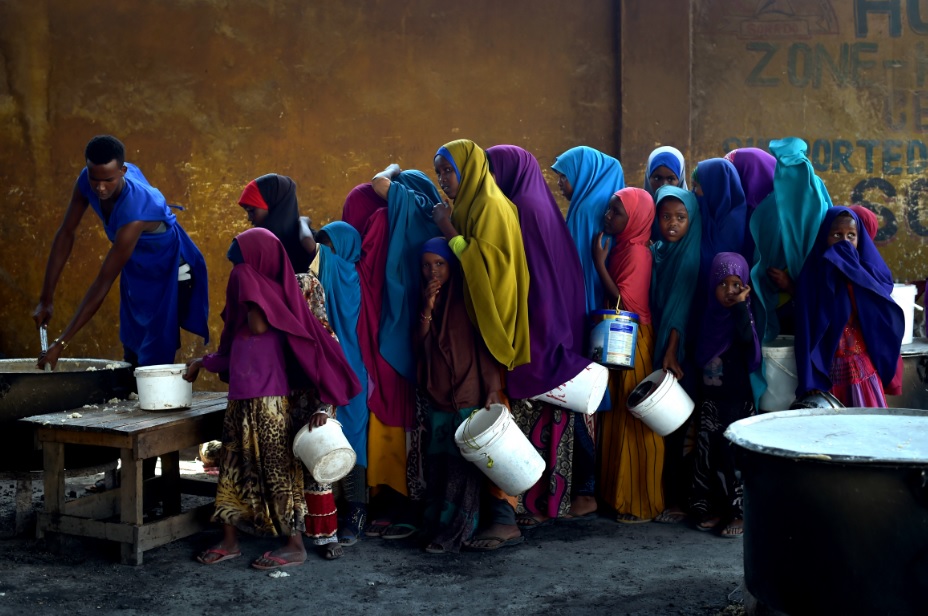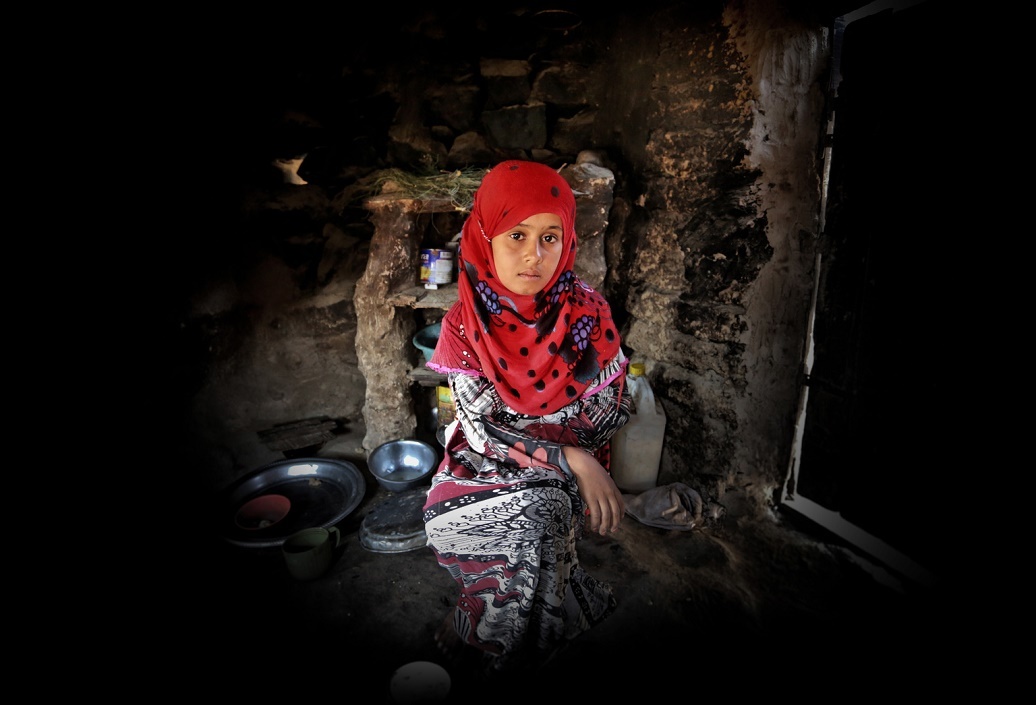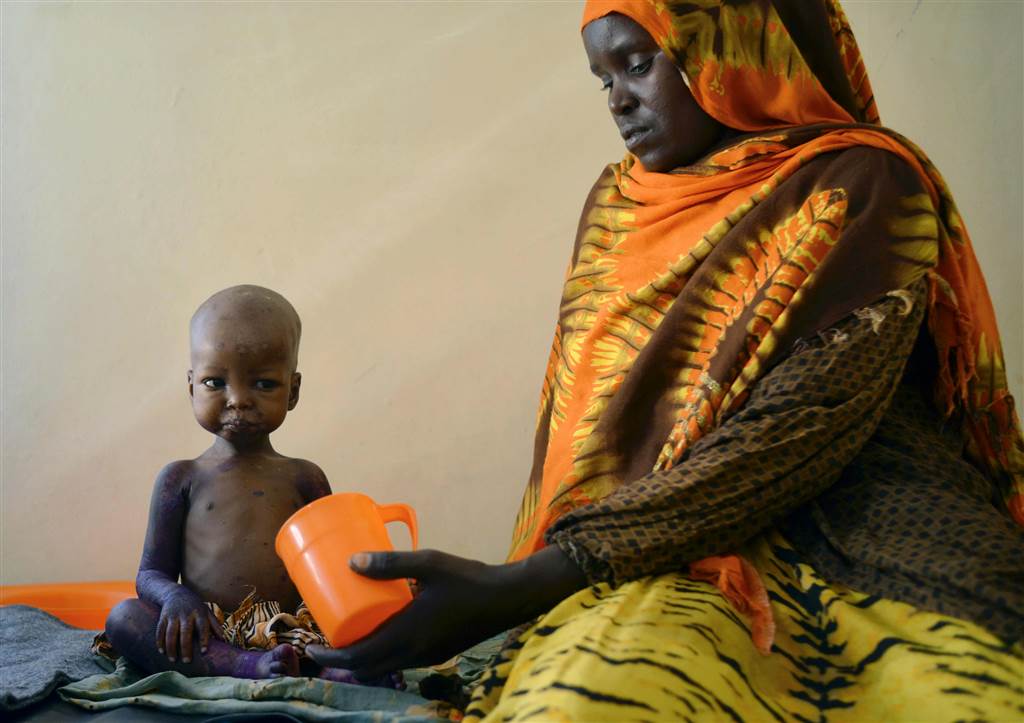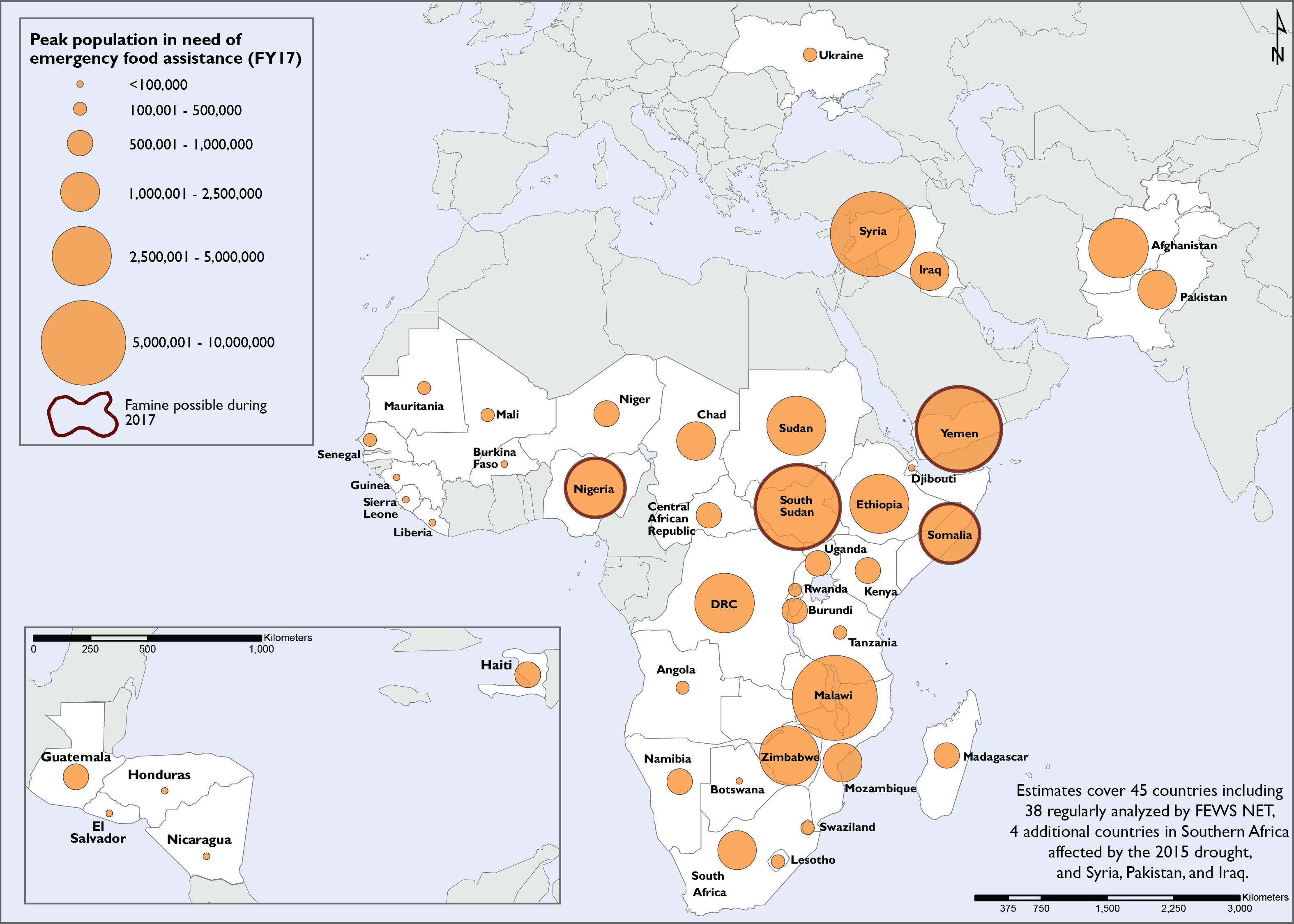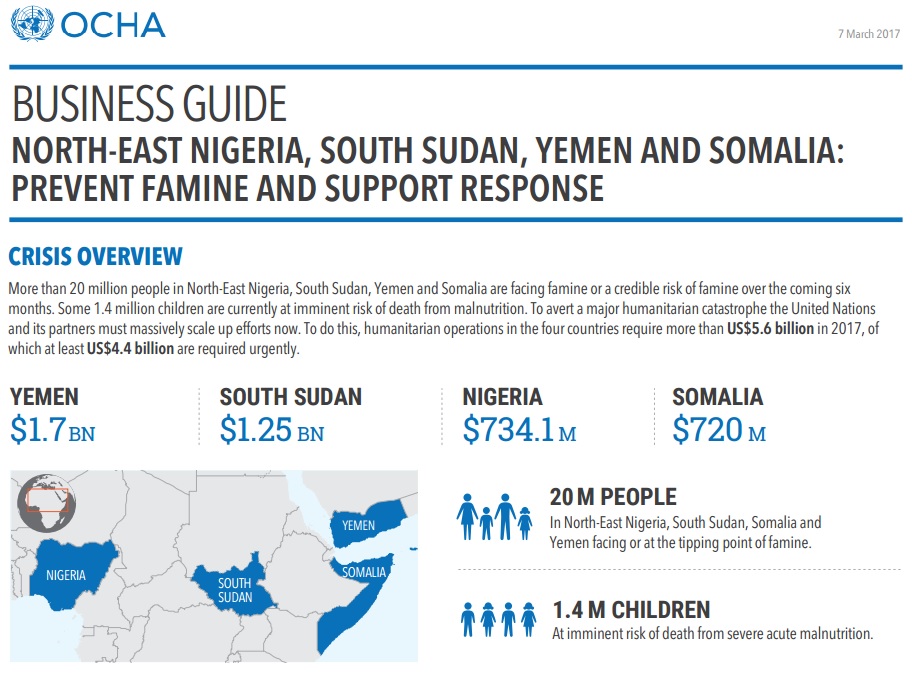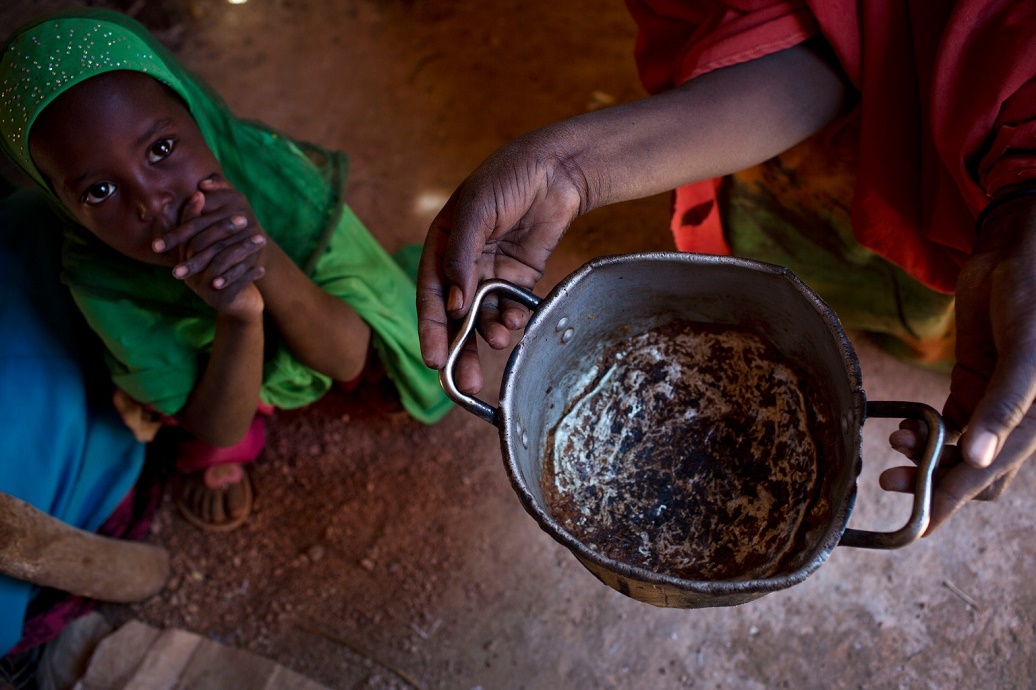Famine was supposed to be a thing of the past. True, 75 million people had died from starvation in the 20th century, but we had learned from these tragedies, how to predict them and how to address them. The largest famines dated back two decades: in the Horn of Africa in 1984-85 and 1992, and in North Korea in the mid-1990s. There had been only one serious famine in the 21st century, and it had occurred in Somalia in 2011, killing 260,000 people.
Now, all of a sudden, the scourge of starvation is back. The news came out over a month ago: 20 million people facing starvation, including 1.4 million children at “imminent risk of death”. The United Nations famine alert concerned four disconnected countries, across Africa and the Arabian peninsula: Nigeria, South Sudan, Somalia and Yemen.
IN THIS PHOTO: Photo was taken in Radfan village in Lahj city. It shows a young girl who is collecting water from a far distance due the water shortage in Yemen. PHOTO CREDIT: UNICEF/UN018342/Askool
The Four-Country Famine: 20 million People at Risk
The UN Secretary General Antonio Guterres did not mince his words at the press conference he held on 22 February in New York. This was a humanitarian crisis in-the-making, it was without precedent in scope and a total of $ 4.4 billion would be needed by the end of March to “avert a catastrophe” (see full transcript here). The Emergency Relief Coordinator Stephen O’Brien and several UN agencies heads (or their representatives) participated in that conference, including WFP (via video), UNDP, UNICEF and FAO (remarkably, not UNHCR).
Even though this was the largest alert in the 21st century and nobody had heard of anything like this for decades, the UN Secretary General’s appeal fell on deaf ears.
Was it a case of crying wolf too many times?
Perhaps, but the news piled up over the next few weeks – shocking news coming from reliable UN sources, here is a sample: “100,000 starve while South Sudan buys weapons”, “Somalia: 110 die from drought in the past 48 hours”, “80,000 children will starve to death in Nigeria” (according to UNICEF) and 120,000 Nigerians likely face Boko Haram-created famine.”
In short, as the world faced its largest humanitarian crisis since World War II, the money to help hasn’t come in.
Stephen O’Brien, the UN Emergency Relief Coordinator, told the UN Security Council on 10 March that “without collective and co-ordinated global efforts, people will simply starve to death” and “many more will suffer and die from disease.”
But he acknowledged that the $4.4 billion of aid called for by the UN Secretary General were really needed by July. So there is still a little time to react.
O’Brien noted that the largest crisis in terms of numbers was Yemen, where two thirds of the population of 18.8 million needed aid and seven million are hungry, “that’s three million more than in January”, he said. The needs are large: $2.1 billion in 2017 to reach 12 million Yemenis “with life-saving assistance and protection” – yet only 6 per cent had been received so far.
Regarding Yemen, O’Brien announced that Secretary-General Antonio Guterres will chair a pledging conference for Yemen on April 25 in Geneva. Unquestionably this is the number one crisis among the four.
The South Sudan crisis, likewise, is man-made, the result of (what is now) a long, drawn-out war. “Parties to the conflict are parties to the famine”, he said, “as are those not intervening to make the violence stop.” In short, all the parties here are in full contravention to international law. And the numbers are appalling: More than 7.5 million people need aid, up by 1.4 million from last year, more than one million children are “acutely malnourished”, including 270,000 children who face “imminent risk of death”. And “the cholera outbreak that began in June 2016 has spread to more locations,” he said.
In Somalia, a quarter of the population, 2.9 million people are at risk of famine and require immediate help. This mirrored the 2011 situation but the UN’s humanitarian partners are better prepared. “To be clear,” he said, “we can avert a famine. We’re ready despite incredible risk and danger … but we need those huge funds now.”
In Northeast Nigeria, the situation that has been festering for the past seven years, has come to a head as Boko Haram has driven 2.6 million from their home and killed 20,000 people – and, as emphasized by UNICEF, children are particularly at risk.
And this week, it looks like the world might be finally waking up to the gravity of the crisis. All the major media have made it frontpage news, from the New York Times to NBC News. The harrowing picture of a malnourished child fed a special formula by her mother at a hospital in Somalia turned into an iconic image:
IN THIS PHOTO: Mother feeding her child, March 15 at a hospital in Baidoa, Somalia – part of a UNICEF- funded health program for children and adults displaced by drought. PHOTO CREDIT: Tony Karumba / AFP – Getty Images
The Trump Effect on Humanitarian Assistance
As President Trump doubles down on his campaign promises, with a series of executive orders and a draft budget announcement that promise a radical change in American foreign policy. The fate of famine victims could well be in his hands if he carries through with his threat to cut $10 billion in foreign aid, taking aim at the UN and its specialized agencies.
The Trump administration has apparently fully embraced the Heritage Foundation arguments that the US should shut down its participation in the UN. As reported in the New York Times, his ambassador to the UN Nikki R. Haley has already made a first move, questioning the annual US contribution to peace-keeping operations (it amounts to 28 percent of the total, or $2.2 billion in 2016). She has requested that this be discussed at the UN Security Council next month, to verify that it is “fit for purpose”.
This, however is a short-sighted move, as it ignores the fact that while very few Americans serve as Blue Helmets (only 70 do), the US benefits abundantly from consultancies and equipment sales through procurement contracts (to the tune of $1.6 billion in 2016). If she carries through with a substantive reduction, this would obviously affect the market for the American military-industrial complex – a small market for military giants, no doubt, but a highly visible one across the world. So to focus exclusively on the 28% America contributes to UN peace-keeping operations is a myopic approach.
Likewise, humanitarian assistance is a mix of give-and-take. For example, it is true that 25% of the World Food Programme budget is provided by the United States. But it is also true that the US contribution opens up the door to a series of lucrative contracts for American firms and experts. Inter alia, this is why the WFP Executive Director has regularly been an American, something that no UN member countries has contested so far, though that could change should the US decide to diminish or even cancel its contribution, as a “punishment” for having “terrorist” countries on its board (like Iran or Syria).
Hopefully, over time, the Trump administration will learn that the donor world is a complex one and that leadership in the international community is highly dependent on the level of donations a country is willing to maintain. Should the US step down, China, Russia and any number of European countries (Germany, France, the UK…) are very likely to step in.
Where will that leave famine victims?
Response to the Current Crisis
As I mentioned above, emergency aid actors have learned lessons from the past and emergency assistance has become far more effective, in particular since Amartya Sen’s seminal paper published in 1981: Poverty and Famines: An Essay on Entitlement and Deprivation.
Up to that point, the traditional analysis of famines concentrated on food supply (or the lack of it). No more. Everyone adopted Amartya Sen’s ’entitlement approach’, which concentrates on ownership and exchange. In other words: the problem with a famine is less lack of food than the inability of some groups to access food even though it may be available. This is why, inter alia, cash transfers are now used in emergency situation, to give money in the hands of victims so they can buy the food and water they need.
For now, barring any problems arising from the Trump administration, the situation among donors is “normal”, and if there has been a delay in donation so far, it is largely the result of a well-known problem, as explained in this excellent article by Prof. Daniel Maxwell, Tufts University and Peter Hailey, founding director of the Centre for Humanitarian Change in Nairobi and former Chief of Nutrition for UNICEF Somalia.
The number one problem could be termed the “early warning/late response” syndrome, a combination of negligence, bureaucratic apathy and political conflicts – sometimes diplomatically referred to as “donor fatigue”.
Another equally common difficulty is establishing “humanitarian corridors”: as state structures collapse in times of war, it becomes very difficult, and sometimes impossible, to ensure access of aid to the victims. The four countries mentioned in this UN alert are especially prone to this kind of problem.
The nature of these problems underlines the importance of getting started early so that there is ample time to obtain from donors the necessary funds and open up the humanitarian corridors needed for aid delivery. And as far as disaster predictions go, the international community has become very good at it, both within the UN and without.
Related article: “HOW THE UNITED NATIONS FORSEES THE FUTURE”
The US stands out with its FEWS NET, the Famine Early Warning Systems Network, established in 1985 by USAID, with support from NASA, NOAA, USDA and USGS, along with Chemonics International Inc. and Kimetrica. It provides evidence-based analysis on some 34 countries, and with additional UN data inputs to cover more, it is able to cover the world. Here are the FEWS NET predictions for 2017, with a “peak population” of people at risk of famine estimated at 70 million across 45 countries :
IN THIS PHOTO: ESTIMATED PEAK SIZE OF THE POPULATION IN NEED OF EMERGENCY FOOD ASSISTANCE DURING FY2017
Sources: FEWS NET, OCHA, Southern Africa RVAC Note the encircled countries: Nigeria, South Sudan, Somalia and Yemen where famine is “on the brink”, as described in United Nations appeal to donors in February.
UN/OCHA has likewise some very cool tools to foresee the crisis and explain what can be done to help. In addition to IASC maps and “early warning early action reports” predicting emergencies, it has developed a handy “business guide” to call for donations from businesses and individuals:
IN THIS PHOTO: The OCHA Business Guide to contribution for a business. Photo Credit: OCHA Business Guide for Four Famines
In addition to giving an overall picture, the OCHA business guide provides for each country a detailed “response plan” developed in collaboration with local UN teams in the four affected countries. If you’re curious, take a look at one of them here: the plan for South Sudan.
For now, the UN system is responding, aid is provided in all four countries, with additional support enabled by special donations. Here are highlights of the response so far:
- 8 March: World Bank announces immediate response action for Ethiopia, Kenya, Nigeria, Somalia, South Sudan, and Yemen, including a financial package of US$1.6 billion to “build social protection systems, strengthen community resilience, and maintain service delivery to the most vulnerable”;
- 17 and 20 March: WFP received a US$8.4 million contribution from the Government of Japan and the second of two shipments of emergency food assistance provided by USAid – notably the press release on USAid’s shipments stated that the US has contributed more than US$1 billion to WFP’s operations in Sudan since 2012;
- 21 March: Food and Agriculture Organization (FAO) received $22 million from the UN Central Emergency Response Fund (CERF) to help affected rural communities in Somalia (FAO is already on the ground).
Except for the World Bank, it is clear that so far abysmally little money has been given to the UN technical agencies. Much more is needed. Trump willing.
IN THIS PHOTO: Amina Dahir holds up an empty cooking pot as she crouches alongside her daughter inside their makeshift home at a settlement near the town of Ainabo, Somalia, Thursday 9 March 2017 PHOTO CREDIT: UNICEF/UN056039/Holt
Looking to the Future: Is a 4-country Famine the New Normal?
The data from Fews Net is profoundly worrying and not just because it predicts 70 million people are at risk this year which is an incredibly high number, but because that number is twice as high as two years ago. Are we into another, riskier world?
Could a 4-country famine alert become the new normal?
It is well known, indisputable even, that famines are a cumulative process made worse by man-made conflicts. But climate change and environmental degradation have a role too and they are making starvation particularly harrowing.
How? Through drought, lack of water. Man can resist lack of food for weeks. Lack of water kills within five days.
This scenario, which is the one being played out, for example, in Somalia right now as I write, is very different from what a famine looked like in the 20th century. In Ukraine, when Stalin’s ruthless policies caused from 7 to 10 million people to starve to death, the sadly famous “holodomor” tragedy in 1932-33, there was no food but there was water. Now there is none.
But the disaster does not stop there. As drought sets in and water turns brackish and polluted with a concentration of worms and bacteria, infectious diseases explode. Refugee camp managers know this dreadful dynamic only too well: As the drought proceeds, camps are literally overrun by newcomers who are increasingly weak and sick. Famine refugees spread throughout, settling in wherever they can, and soon camp facilities are overwhelmed. And it is not long before a cholera epidemic spreads through the whole camp population. And of course, as is well known, infectious diseases are the real killers.
This suggests that new methods will need to be developed to overcome the threat of future famines. For now, technology has given us ready-to-use supplemental therapeutic food that helps victims recover faster, but we need more.
 IN THIS PHOTO: Scooping ready-to-use therapeutic food doses into 90ml doses at Farah Hospital, Afghanistan (October 2009) PHOTO CREDIT: Wikimedia Commons
IN THIS PHOTO: Scooping ready-to-use therapeutic food doses into 90ml doses at Farah Hospital, Afghanistan (October 2009) PHOTO CREDIT: Wikimedia Commons
Among aid experts, much attention has been given in recent years to building up “resilience” in people, indeed, this is the new buzzword within the United Nations and in the international community. Resilience is now part and parcel of the broader concept of “sustainability”. i.e. of sustainable growth to ensure a better future. As explained on the UN/Sustainable Development Goals website, consistent efforts have been made with support from the World Bank (to the tune of $1.5 billion) to “integrate resilience and sustainable development” in the 2030 Agenda, as called for in the “Sendai Framework for Disaster Risk Reduction 2015-2030“, adopted in Japan, on March 18, 2015. This makes sense once the crisis has passed and one needs to get ready for the next crisis: After all, fragile economies like Somalia’s or South Sudan’s certainly need strengthening to better face the next disaster.
But we also need to better address the crisis while it’s on-going. In addition to increasing the quality of information about the disaster (who is hurt, where, what is needed), we also need to manage the assistance better. The weak link is often the refugee camps because, as a quick glance to any budget for assistance will immediately reveal, funds tend to be directed to food and supplies rather than to camp management that gets whatever is leftover. Food and supplies are viewed as priorities, and what it takes to distribute them and ensure recovery is not given the attention it deserves.
Perhaps the reason for this unwillingness to finance good management arises from a lingering suspicion that it amounts to fund diversion, that perhaps somebody’s pockets are lined at the expense of the disaster victims. Yet, with solid monitoring and evaluation tools in place, there is no reason to be concerned, fund disbursement and management can be kept under close watch.
The point is that, to ensure full and fast recovery, we need new and better camp management systems. We need more well-trained managers and staff to properly care for the famine victims, so that the camp population is not overwhelmed by infectious diseases. That means more money should be allocated to camp management and structures, to innovation and new ideas to address the threat of famines. And that includes building up stronger paths to recovery through additional activities, for example, training for new skills that will accelerate exit from the crisis situation and a return to “normal” sustainable development.
We should resist the temptation that all that’s needed is to provide food and medical help, we should be ready to spend funds in different, innovative ways to really sustain the victims, help them recover and launch them back into a full life – not merely scraping by.
HOW TO DONATE: WFP, UNICEF, SAVE THE CHILDREN
Recommended reading: “EMERGENCY FOOD SECURITY INTERVENTIONS – BEST PRACTICES”


